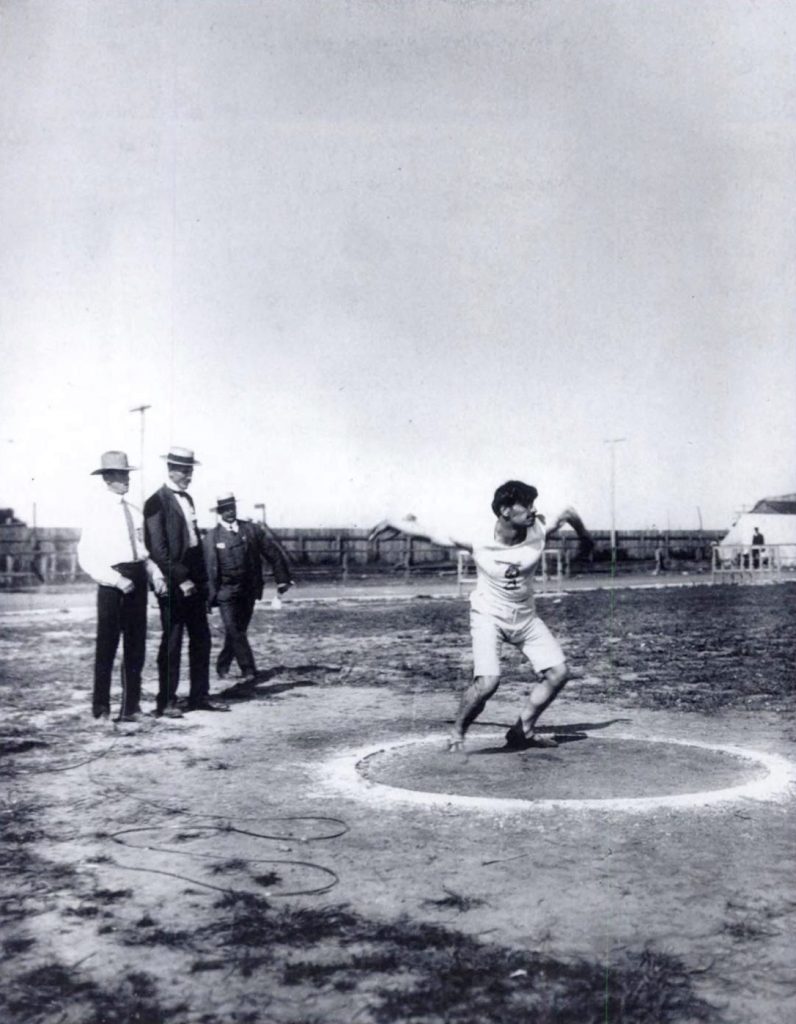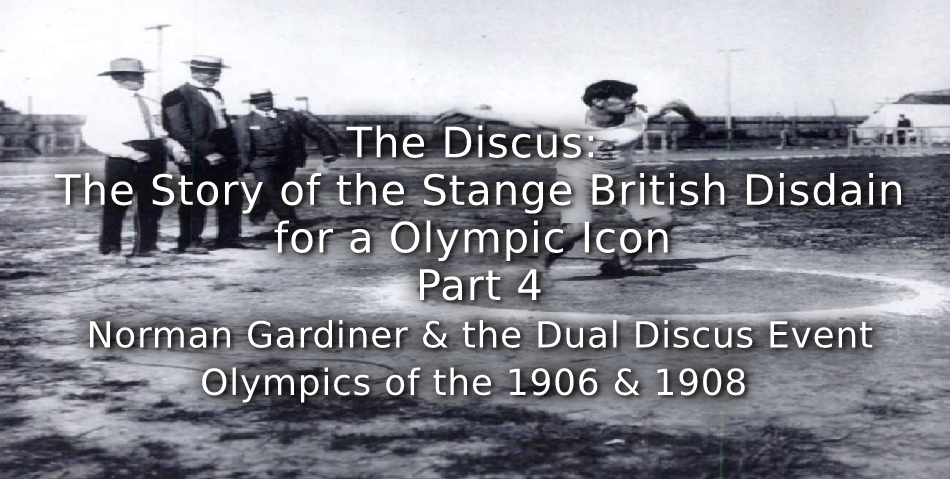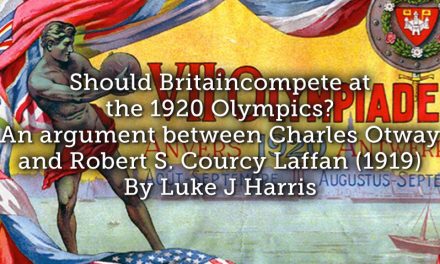To read Part 1: Classical Origins – Click HERE
Part 2: Early British Interest (and Disinterest!) in the Discus – Click HERE
Part 3: Greek Revival and British Academic Objections – Click HERE
While modern discus throwing techniques had been developed by athletes, the English classicist E. Norman Gardiner was attempting to analyse historical and archaeological evidence to understand how the ancient Greeks had thrown. In 1907 he published a lengthy paper, Throwing the Diskos, in the Journal of Hellenic Studies. Early on in his paper Gardiner returned to West’s observation regarding the use of a thong to throw the discus.

E. Norman Gardiner
In the century and a half since West’s time some German scholars had suggested that there had been two throwing events in antiquity, the discus and the solos, the latter being more akin to the modern metal shotput. They were divided over whether a thong was used in one or the other form of throwing. Gardiner took the view that the word solos merely referred to any mass of metal, and that it usually referred to basic ingots from the smelting process which were used for trading or as ballast in ships. These may have been casually used for throwing competitions at times, which may in turn have led to some interchangeability between the words discus and solos in casual use. Gardiner certainly thought this was the case, although he was inclined to interpret them in one way or another to best fit his argument. Along with his friend John Myres, he decided that references in the Iliad to the use of a solos with a thong were erroneous, and in fact referred to some other unnamed weapon, similar to the South American bolas.
Gardiner’s position was that the discus originally started out as a competition in which any convenient stone was thrown, but that it eventually evolved, first into a stone disc, and later a metal one. Metal versions of the discus were made of hammered or cast bronze, or occasionally lead. Gardiner included a table of 15 different examples including their weights and dimensions. The majority of these were around 20 centimetres in diameter and two kilos in weight, which meant that they were of very similar size to the discus used in modern athletics. In 1914, F.A.M. Webster. British javelin champion and secretary of the Amateur Field Events Association, stated that the example from Aegina referred to in the table was most likely representative of those most commonly thrown in events.
Yet immediately after setting out evidence which apparently authenticated the size of the modern discus, Gardiner condemned it stating,
In the last Olympic games, a wooden diskos with a metal centre was used. It is a thick clumsy object, the product of modern imagination, utterly unlike and in every way inferior to the specimens which we have in our museums. There is no authority for it whatsoever.
If Gardiner’s objection was merely that the modern discus was a composite affair of wood and metal, he may have had a point about its authenticity, but his level of outrage seems excessive given that the size and weight appears to be broadly correct.
The data for Gardiner’s table had been collected by Robert Carr Bosanquet, who had just returned to teach archaeology at the University of Liverpool, after several years at the British School in Athens. As an undergraduate at Trinity College, Cambridge, in 1892 he had struggled with German descriptions of the discus and wrote to his sister that he was having a 12-pound discus made, with which he intended to work out whether Phayllus’ reported throw of 95 feet was feasible. Unfortunately, he didn’t report how he got on, although based on Garrett’s experiences at Princeton, he probably got nowhere near that mark, if he could throw it at all. Bosanquest later suggested to Gardiner that the ancient Greeks may have had different sizes of discus for boys, youths and men, a suggestion that Gardiner accepted with enthusiasm, not least because it created a convenient means of skewing the data to claim that the ancient discus was much larger than the modern one.
Bosanquet had been a leading hammer thrower in his time and had been one of the British representatives to the IOC for the 1906 Intercalated Olympic Games in Athens. Interestingly, the 1906 Games tried to cope with controversy over the nature of the discus by holding two separate events. The main competition at the Panathenaic stadium saw athletes throw using the modern rotating technique, while a second event was held at the National Gymnastic Club in which the competitors were asked to throw from a plinth, in a style which the organisers imagined replicated classical discus throwing. Unfortunately, the instructions were a little vague.
The thrower places himself on the pedestal with the feet apart, and holding the discus in either hand. He then takes it with both hands slightly stretched, lifting them without letting go the discus, and stretching out the rest of his body in the same way in the same direction. After that he turns the trunk slightly to the right and bends sharply, so as to bring the left hand when free to the right knee, and the right hand still holding the discus, as far back as the build of the shoulder permits. At this moment, the right foot should be forward and the legs bent; the right foot rests on the sole, and the left on the toes only. Then by a sharp and simultaneous extension of the whole body, the thrower throws the discus straight in front of him.
In the event it proved somewhat difficult to enforce these rules, with controversial results. The Greek favourite, Nikolaos Georgantas, who had rigidly followed them, was leading, but was overtaken by Verner Järvinen of Finland on the final throw. Georgantas was outraged as he felt the Finn had not kept to the restrictions of the Greek style and demonstrated his displeasure by stepping back onto the plinth and exceeding the winning throw by several metres by emulating Järvinen’s technique.

Nikolaos Georgantas seen here competing at the St Louis Olympics of 1904

Verner Järvinen of Finland
In his 1907 article, Gardiner criticised the plinth, or balbis, used for the Greek style discus at the Athens games. The organisers had accepted an inaccurate translation of an obscure passage in Philostratus which had led them to create the plinth with a downward slope towards the front. Gardiner was able to find a wealth of evidence from other sources and scholars to contradict this misunderstanding, and the event was eventually withdrawn from the Olympic games, though not before it had been held under the same rules for a second time at London in 1908.
Gardiner was also critical of the circle used for the modern discus. He accepted that the discus could be thrown a long way using modern techniques, but suggested that without the precedent of hammer throwing nobody would ever have thought of swinging around to gain momentum for the throw. He thus turned his attention to the ancient evidence. He quickly dismissed all of the ancient literary sources as either contradictory or incomplete and decided to go forward by looking at a combination of sculpture, decoration on vases and representations on coins. These provide an astonishing array of poses, some of which represent positions mid throw while others are clearly at rest. Unfortunately, there are none representing the moment of release or just after, which rather hampers putting together a definitive sequence in which the available positions might fit together.
However, Gardiner, assisted by George Robertson, came up with a sequence he felt was plausible. This essentially involved stepping forward while raising the discus high, stepping back and swinging it down and round towards the back and then swinging forward and releasing the discus on an upward trajectory as one stepped back forward. Unsurprisingly this was the method used by Robertson at the 1896 games.
Article © of Andy Carter
To read Part 5: Preposterous and No Man in His Right Mind Would Throw It – Click HERE





